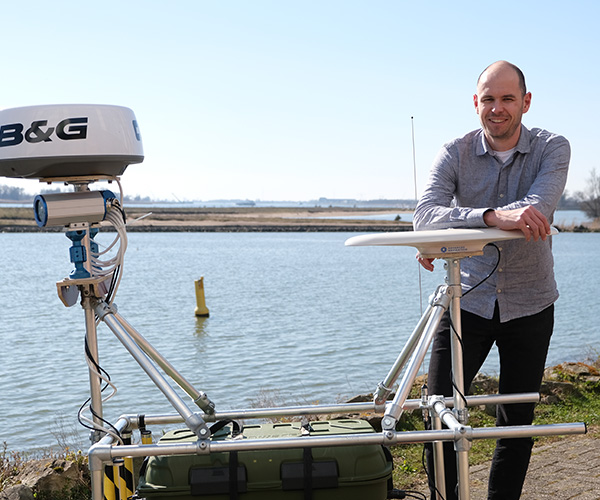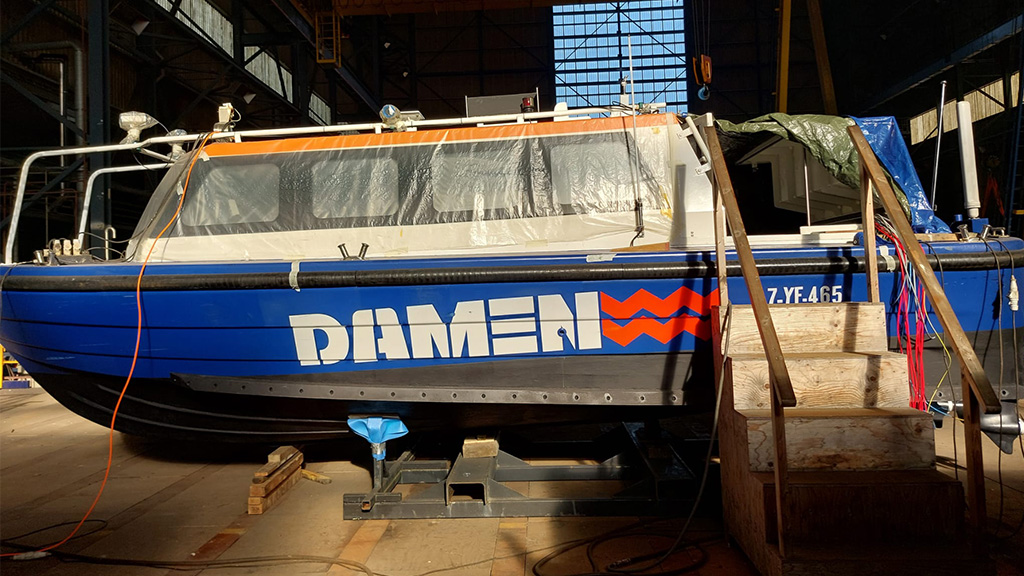Vlissingen-Oost is currently home to a couple of seriously large ships. There’s the REV Ocean – the world’s largest yacht at a whopping 194.9-metres – at Damen Shiprepair Vlissingen. And until recently Combat Support Ship Den Helder could be found along the quay at Damen Naval, coming in at a sizeable 179.5 metres. However, it’s not only the big ships that deserve the attention; the F.A.S.T. vessel that is currently being renovated into an electrically powered and autonomous vessel proves that size isn’t everything. In addition, the F.A.S.T. team has welcomed a new member: Autonomy Engineer John Spruit.
The star of the show in Damen Naval’s Fieldlab Autonomous Sailing Technology (F.A.S.T.) project is a 1990-built Damen Stan Patrol 900. At just nine metres in length, it’s a safe bet to say that this is the smallest vessel being worked on at Vlissingen-Oost.
With the vessel’s new electric motors and batteries installed last autumn, the project team is now working closely with project partner Alewijnse to complete the electrical scope of work. This involves cable pulling and connecting the new equipment. At the same time, another project partner Praxis is wrapping up their work on the vessel’s software package; they will start their commissioning process once Alewijnse has finished their work.
 Autonomy Engineer John Spruit.
Autonomy Engineer John Spruit.
“Our aim is to get the ship up and running ASAP,” says John. “This is to prepare the vessel for a week of testing in Scheveningen in June.” This test week is being organised by COMMIT (the Dutch Ministry of Defence’s Materiel and IT Command) and will involve three participants and three vessels. “There will be one from Fugro, one from DEMCON, and our F.A.S.T. boat. Together we are working on – and will be showing – a common software architecture. At the same time, we also want to demonstrate and compare our individual capabilities,” he continues.
In what John describes as an atmosphere of “collaboration with a healthy dose of competition”, the three vessels will be tested on their autonomous ability “to comply with four critical COLREG [the IMO 1972 Collision Regulations] scenarios which encompass head-on, crossing, overtaking, and give-way situations”.
John is the newest member of the F.A.S.T. team, joining Damen Naval in August 2024. As Autonomy Engineer, his role is the autonomous sailing scope of the project. “A big part of this is to work on the vessel’s perception, translating what its sensors see into a digital representation of the real-world situation which the autopilot software can interpret, make decisions and act upon.”
 The project team is working closely with project partner Alewijnse to complete the electrical scope of work.
The project team is working closely with project partner Alewijnse to complete the electrical scope of work.
Since last year, the Vlissingen-based F.A.S.T. team has been working closer with the autonomy team within the RD&I department at Damen’s Gorinchem head office. “They are working on a larger number of sensors – RGB cameras, infrared cameras, radars, and map data – to reach an autonomous solution that guarantees safe sailing. We will also use their findings to shape a sensor solution for the F.A.S.T. project,” says John.
John’s previous job was in the self-driving car sector. “There are definitely parallels between the maritime and automotive sectors; there are full autonomous solutions that can be applied to the maritime domain,” he states. “However, maritime projects face numerous extra challenges particularly due to the harsh environment that the ship operates in. This is why maritime autonomy is lagging behind the aerospace and automotive sectors.” John shares the ambition of his fellow team members: “I like the collaboration within Damen, but also outside Damen; with COMMIT and the other partners too. It’s a nice project to be working on, with specific challenges that have not been solved before.”

